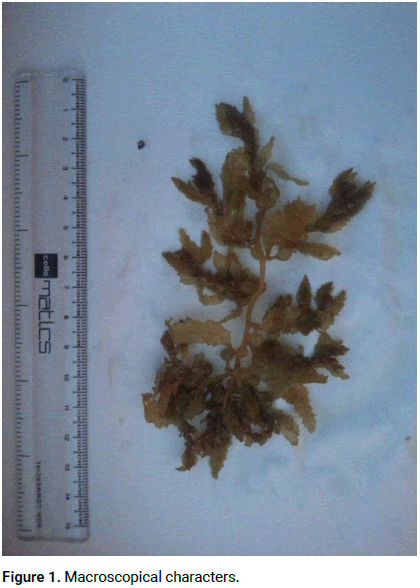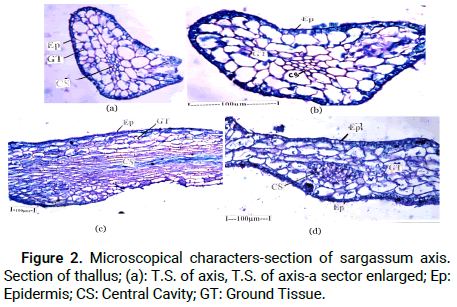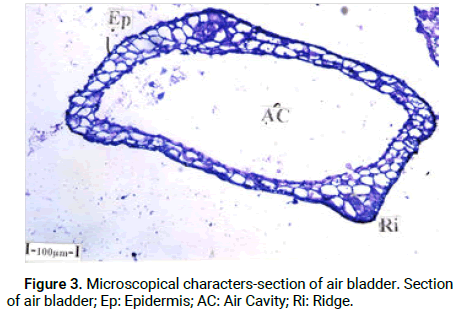Research Article - (2025) Volume 6, Issue 1
Sargassum wightii a marine brown seaweed found along the coastal areas of Rameswaram, Tamil Nadu, India and studied for its anatomical and phytochemical properties to check the authencity of the plant. Morphological characters of the thallus-axis has been studied to aid pharmacognostic and taxonomic species identification using photographs; parameters presented in this paper may be proposed to establish the authenticity of this plant and can possibly help differentiate the alga from its other species. The study revealed several interesting characters like air bladder and the axis is differentiated into meristoderm, cortex and medulla rich in chromatophores. Phytochemically rich in phenols, tanins and flavanoids.
Alga • Authentic • Marine • Micromorphological • Phaeophaceae • Sargassum
Traditional systems of medicine are prominent in India and medicinal plants form the backbone of traditional systems of medicine. A number of tribal communities still use folklore medicinal plants for the cure of various diseases. The great interest in the use and importance of medicinal plants in many countries has led to intensified efforts on the documentation of ethnomedical data of medicinal plants [1]. The recent increase in compounds isolated from land plants, has open doors to the poorly exploited marine ecosystem which appears to be a good candidate of natural resource [2]. The aquatic ecosystem covers about 70% of the earth’s surface and India has a vast coastline of 6100 km supporting a rich flora of marine plants such as seaweeds, mangroves and sea grasses [3]. Marine algae exhibit interesting nutritional properties in addition to their ecological properties [4].
Collection of specimens
The plant specimen for the proposed study was collected from Rameswaram, Tamil Nadu, India during the month of March authenticated by Dr. R. Thevanathan, Reader, Presidency College, Chennai. Care was taken to select healthy plants and normal organs.
Anatomical studies
Processing: The required samples of different organs were cut and removed from the plant and fixed in FAA (4% Formalin Acetic Acid). After 24 hrs of fixing, the specimens were dehydrated with graded series of tertiary-Butyl alcohol (50%-100%) as per the schedule given by [5]. Infiltration of the specimens was carried by gradual addition of paraffin wax (melting point 58°C-60°C) until TBA solution attained super saturation. The specimens were cast into paraffin blocks.
Sectioning: The paraffin embedded specimens were sectioned with the help of rotary microtome. The thickness of the sections was 10-12 μm. Dewaxing of the sections was by customary procedure [6]. The sections were stained with Toluidine blue as per the method published by [7]. Since Toluidine blue is a polychromatic stain. The staining results were remarkably good; and some cytochemical reactions were also obtained. The dye rendered pink colour to the cellulose walls, blue to the lignified cells, dark green to suberin, violet to the mucilage, blue to the protein bodies.
Photomicrographs: Microscopic descriptions of tissues are supplemented with micrographs wherever necessary. Photographs of different magnifications were taken with Nikon LabPhoto 2 microscopic unit. For normal observations bright field was used. Magnifications of the figures are indicated by the scale-bars.
Screening for phytochemicals
Different extracts such as methanol, and chloroform:methanol (2:1) were screened for the presence of phenols, flavonoids, tannin, saponin, alkaloids, glycosides, phytosterols by using standard protocols [8,9]. Extract preparation was done by dissolving 10 gms of the dried plant extract in 100 ml of the solvents respectively. Vaccum dried and used for further screening.
Macroscopical characters
Plants having short, stout axis brown in colour bearing terate, smooth, primary branches at their upper part, beset with secondary branches and branchlets; basal leaves membranaceous, oblong, about 2-3 cm long, 5-8 mm broad, rounded at the apices and dentate at the margins; leaves of the branchlets lanceolate, 2-3 cm long, 3 mm borad, cuneate at the base. The air bladders are in spherical shape about 4 mm diameter, obovate, axillary and subcylindrical (Figure 1).

Figure 1: Macroscopical characters.
Microscopical characters
The axis is broadly oval to polygonal in cross sectional view (Figure 2). The axis is 2.22 mm in diameter. It consists of thin layer of small thick walled closely arranged uniseriate layer with darkly stained epidermis Ep or meristoderm rich in chromophores and parenchymatous ground tissue GT. The outer ground tissues include fairly thick walled smaller angular cells with intercellular spaces. The central ground tissue is occupied by a thick-walled region or medulla or Conducting System (CS) includes circular, slightly larger thin walled cells Lateral walls of medulla bear some scalar form thickenings.
The air bladder is circular in section with wide empty central space or air cavity AC which has shallow ridges Ri on the surface. The bladder has a thick epidermal layer of square cells with inner compact parenchymal cells with no cell inclusion (Figure 3).

Figure 2: Microscopical characters-section of sargassum axis. Section of thallus; (a): T.S. of axis, T.S. of axis-a sector enlarged; Ep: Epidermis; CS: Central Cavity; GT: Ground Tissue.

Figure 3: Microscopical characters-section of air bladder. Section of air bladder; Ep: Epidermis; AC: Air Cavity; Ri: Ridge.
Phytochemical screening
Phytochemical screening reveal the presence of tannin, saponin and flavonoids (Table 1).
| Serial number | Constituents | Methanolic extract | Chloroform:methanol extract |
|---|---|---|---|
| 1 | Alkaloids | + | + |
| 2 | Steroids | + | + |
| 3 | Tanin | + | + |
| 4 | Saponin | + | + |
| 5 | Flavanoids | + | + |
| 6 | Phenols | + | + |
| 7 | Phlobatannins | + | + |
| 8 | Glycosides and sugars | - | - |
| 9 | Fats and oils | - | + |
| 10 | Terpenoids | + | + |
| Note: *Shade dried powdered material; (+): Presence and (-): Absence | |||
Table 1. Qualitative analysis of phytochemicals.
The above parameters help in identifying the species and establishing the authenticity of this seaweed and can possibly help differentiate it from its other adulterants.
The micromorphological analysis of Sargassum wightii axis provides valuable insights into its structural organization and biochemical composition. The observed characteristics, such as the presence of air bladders and the differentiation of the axis into meristoderm, cortex, and medulla, are consistent with previous studies on brown seaweeds within the Sargassum genus. These features contribute to the unique identity of S. wightii and serve as diagnostic criteria for species authentication.
Furthermore, the phytochemical screening revealed the presence of phenols, tannins, and flavonoids in S. wightii extracts. Phenolic compounds are known for their antioxidant properties, while tannins exhibit antimicrobial and antiviral activities. Flavonoids, on the other hand, have been associated with various biological activities, including anti-inflammatory and anticancer effects. The presence of these bioactive compounds underscores the potential pharmacological significance of S. wightii in traditional medicine and drug discovery efforts.
The comparison of our findings with previous studies on related species highlights both similarities and differences in micromorphological and phytochemical profiles. For instance, S. wightii shares structural features with other Sargassum species, such as S. muticum and S. polycystum, yet distinct differences exist in their chemical compositions. These variations reflect species-specific adaptations and ecological niches within the genus, emphasizing the importance of accurate species identification for biomedical and ecological research.
In conclusion, this study contributes to the comprehensive understanding of S. wightii by elucidating its micromorphological characteristics and phytochemical composition. The documented features serve as valuable tools for species identification and authentication, essential for quality control in herbal medicine and natural product industries. Moreover, the presence of bioactive compounds suggests the therapeutic potential of S. wightii in various health conditions, warranting further investigation through preclinical and clinical studies. Overall, this research underscores the importance of marine biodiversity conservation and sustainable utilization of marine resources for human welfare and scientific advancement.
[Google Scholar] [PubMed]
[Crossref]
Citation: Sethi P. "Micromorphological Studies on the Axis of Sargassum wightii Greville ex J. Agardh (Phaeophyceae)". J Cell Mole Biol Res, 2024, 5(1), 1-3.
Received: 11-Jun-2023, Manuscript No. JMCB-23-102059; Editor assigned: 13-Jun-2023, Pre QC No. JMCB-23-102059 (PQ); Reviewed: 04-Jul-2023, QC No. JMCB-23-102059; Revised: 03-Jan-2024, Manuscript No. JMCB-23-102059 (R); Published: 10-Jan-2024, DOI: 10.35248/JMCB.24.5(1).001
Copyright: © 2024 Sethi P. This is an open-access article distributed under the terms of the Creative Commons Attribution License, which permits unrestricted use, distribution, and reproduction in any medium, provided the original author and source are credited.